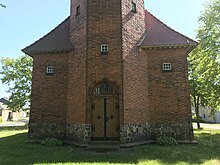Schönefeld village church (Nuthe glacial valley)
The Protestant village church Schönefeld is a hall church in Schönefeld , a district of the municipality Nuthe-Urstromtal in the Teltow-Fläming district in the state of Brandenburg . The church belongs to the parish of Zossen Fläming the Evangelical Church Berlin-Brandenburg-Silesian Oberlausitz .
location
The Neuhofer Straße leads from the west in an easterly direction through the village. It spans the historic village green on which the church stands on a slightly raised, unfenced area.
history
There are partly contradicting information about the building history. The Baruther Urstromtal Friends Association states that the church was built in 1853, but was destroyed in a fire in 1907. The Brandenburg State Office for the Preservation of Monuments and the State Archaeological Museum (BLDAM) does not describe a previous building, but assumes a construction period between 1910 and 1911. The Dehio manual only indicates a building from 1911. The design comes from the Berlin government master builder Erich Schonert. It is conceivable that there was at least one previous building: One of the bells dates from the 13th century; another from 1678. Since Schönefeld was built as a “German” settlement north of the Hammerfliess in competition with the Slavic founding in Dümde with its own church from 1793, a previous building seems likely. The base made of field stones also speaks for an earlier sacred building. The consecration took place on November 11, 1914.
Building description
The building was essentially made of reddish bricks on a base made of uncut and non-layered field stones. The choir is not drafted and is three-sided. On the north-east and south-east side there is a raised ox - eye , of which the south-eastern one is still in its original state and shows a wine motif. The east wall is closed.
The nave is dominated on each side by three large arched windows that were distributed over the facade. It has a simple gable roof , which is covered with beaver tail .
This is followed by the west tower . It initially takes up the full width of the ship, but then changes to an octagonal shape. It can be entered from the west through a large arched portal. There you can read the inscription “Commit your ways to the Lord” (and hope in him; he will do it) from Psalm 37 : 5. On the north wall is a small, raised rectangular window. A similar window was installed on the south side; but subscript there. Two more windows are built into the west facade. Below the bell storey is a tower clock on four sides. Eight high rectangular sound arcades are built in above . On top is an octagonal tent roof with a weather vane .
Furnishing
The church furnishings, consisting of a pulpit altar in green-gray tones , Fünte , west gallery and chandelier are described in the Dehio manual as "atmospheric". It is neo-baroque and dates from the construction period.
A memorial to the east of the building commemorates those who died in the world wars.
In the tower hangs a bell from the 13th century and another bell that Georg Billich from Wittenberg cast in 1678.
literature
- Georg Dehio (edited by Gerhard Vinken et al.): Handbook of German Art Monuments - Brandenburg Deutscher Kunstverlag, Munich / Berlin 2012, ISBN 978-3-422-03123-4 .
- Evangelical Church District Zossen-Fläming Synodal Committee for Public Relations (Ed.): Between Heaven and Earth - God's Houses in the Church District Zossen-Fläming , Laserline GmbH, Berlin, p. 180, 2019
Web links
Individual evidence
- ↑ Schönefeld , website of the Baruther Urstromtal Förderverein, accessed on May 1, 2018.
Coordinates: 52 ° 4 ′ 46.7 ″ N , 13 ° 19 ′ 27.2 ″ E

